

Patents. Patents. Patft » Page 1 of 1. Geschmacksmuster. Patentrecht. Patent. Urkunde zu einem US-Patent Ein Patent ist ein hoheitlich erteiltes gewerbliches Schutzrecht für eine Erfindung. Der Inhaber des Patents ist berechtigt, anderen die Nutzung der Erfindung zu erlauben oder zu untersagen. Das deutsche Wort wurde im 17. Jahrhundert aus dem französischen patente („Bestallungsbrief, Gewerbeschein“) entlehnt.
Dieses ist gekürzt aus lettre patente („offener Brief“) und geht auf das lateinische (littera) patens („offener (Beglaubigungs-)Brief des Landesherrn“) zurück. Deutsches Patent- und Markenamt. 02_dpmainformativ_schriftenartencodes. 03_DPMAinformativ_IPIA. Patents. Home. Home. Home. United States Patent and Trademark Office. United States Patent and Trademark Office.
Die Beschlagnahme von Feindpatenten im Zusammenhang mit dem Zweiten Weltkrieg. Das Reichsgesetzblatt, Teil I. und II. kann man bei der österreichischen Nationalbibliothek einsehen. (1) Blatt für Patent-, Muster- und Zeichenwesen, Nr. 3, 30.
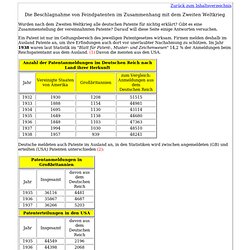
März 1939, Seite 34 (Während des Krieges wurden Auslandsanmeldungen nicht mehr in der Statistik veröffentlicht.) (2) Angaben für Großbritannien aus: Blatt für Patent-, Muster- und Zeichenwesen, Nr. 6, 30. Juni 1938, Seite 147 f Angaben für USA aus: Journal of the Patent Office Society, Washington, D.C., February, 1939, Seite 128. Patent. A patent (/ˈpætənt/ or /ˈpeɪtənt/) is a set of exclusive rights granted by a sovereign state to an inventor or assignee for a limited period of time in exchange for detailed public disclosure of an invention.
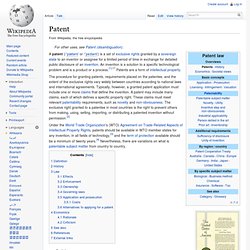
An invention is a solution to a specific technological problem and is a product or a process.[1]:17 Patents are a form of intellectual property. Under the World Trade Organization's (WTO) Agreement on Trade-Related Aspects of Intellectual Property Rights, patents should be available in WTO member states for any invention, in all fields of technology,[3] and the term of protection available should be a minimum of twenty years.[4] Nevertheless, there are variations on what is patentable subject matter from country to country. Definition[edit] Directory of Intellectual Property Offices. Patents by technology. A new union, a fresh approach, a better chance! Patent. Patent – potocznie: dokument wydawany przez urzędy patentowe; właściwie: ograniczone w czasie prawa właściciela rozwiązania technicznego do wyłącznego korzystania z wynalazku bądź wynalazków będących przedmiotem patentu w celach zawodowych lub zarobkowych na terenie państwa, które decyzją administracyjną patentu udzieliło, pod warunkiem wniesienia opłat za co najmniej pierwszy okres ochrony od daty zgłoszenia.
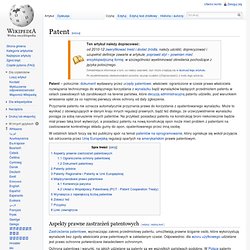
Przyznanie patentu nie oznacza automatycznie przyznania prawa do korzystania z opatentowanego wynalazku. Może to wynikać z obowiązujących w danym kraju innych regulacji prawnych, bądź też dlatego, że urzeczywistnienie wynalazku pociąga za sobą naruszenie innych patentów. Na przykład: posiadacz patentu na konstrukcję broni niekoniecznie będzie miał prawo taką broń wytworzyć, a posiadacz patentu na nową konstrukcję opon może mieć problem z patentami na zastosowanie konkretnego składu gumy do opon, opatentowanego przez inną osobę. 특허. 위키백과, 우리 모두의 백과사전.

특허(特許, 영어: patent)는 발명을 한 자 또는 그의 정당한 승계인에게 그 발명을 대중에게 공개한 대가로 일정 기간 동안 배타적인 권리를 주는 행정행위를 말한다. 특허를 주는 절차 및 특허권자가 되기 위한 주체적 요건, 특허권에 대한 배타적 효력의 범위는 나라마다 각각 법률에 규정한 바가 다르다. 그러나 특허 출원 신청은 일반적으로 한 개 이상의 발명으로 이루어진 청구항들로 이루어져 있어야 하며, 각각의 발명은 신규성과 진보성, 그리고 산업상 이용가능성을 갖추어야 한다. 대부분의 나라에서는 특허권자에게 그 특허발명에 대해서 생산, 사용, 양도, 대여, 수입, 양도 또는 대여의 청약을 할 배타적 권한을 부여한다. 특허 제도의 목적은 타인의 부당한 특허권 침해에 대해 민·형사적 제재를 인정함으로써 공정한 기술경쟁을 유도하며, 독점배타권인 특허권을 부여함으로써 발명의 보호·육성에 따른 기술진보를 촉진시켜 결국 산업발전에 이르도록 하고자 함이다. 출원 공개 제도는 발명을 비밀상태에서 해제하여 누구라도 활용할 수 있도록 함으로써 문헌정보를 통한 기술발전에 이바지한다. 정의[편집] 특허란 보통 새롭고 유용한 물건이나 그 물건의 제조방법, 물질의 새로운 결합방법이나 물질의 유용한 용도를 발명한 자는 누구나 받을 수 있는 권리를 의미한다. 기존의 발명을 다소간 변형하였으나 그 실질에 있어서는 기존의 발명과 동일한 경우에는 동일성의 범위 내에 있는 것으로서 신규성이 없다. [1] :310 특허 출원된 발명에 신규성이 없다고 하기 위해서는 그 발명과 출원 전에 공지된 발명이 동일한 것이어야 한다. 特許. 特許(とっきょ、英: Patent、パテント)とは、法令の定める手続により、国が発明者またはその承継人に対し、特許権を付与する行政行為[1]。
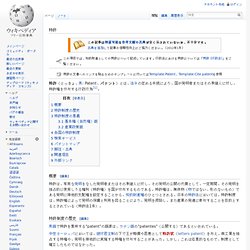
Brevet. Un article de Wikipédia, l'encyclopédie libre.

Un brevet est un titre de propriété industrielle qui confère à son titulaire non pas un droit d'exploitation, mais un droit d'interdiction de l'exploitation par un tiers de l'invention ou le procédé brevetés, à partir d'une certaine date et pour une durée limitée (20 ans en général). Certains États peuvent au moment de l'inscription délivrer un « brevet provisoire », et peuvent accorder un « délai de grâce »[1] qui évite la nullité du brevet pour un inventeur ayant exposé son invention avant le dépôt de brevet, dans un cadre non confidentiel, avec comme avantage de permettre la diffusion rapide des connaissances techniques tout en réservant l'exploitation industrielle de l'invention, mais avec quelques inconvénients[2]. Selon les pays c'est le premier « inventeur » ou le premier « déposant » (en Europe) qui a priorité pour le brevet. Le brevet n'est valable que sur un territoire déterminé, pour un État déterminé. 1.
Patente. Números de patente.
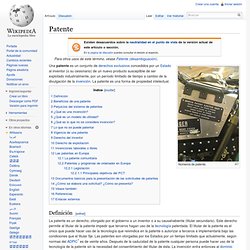
Una patente es un conjunto de derechos exclusivos concedidos por un Estado al inventor (o su cesionario) de un nuevo producto susceptible de ser explotado industrialmente, por un período limitado de tiempo a cambio de la divulgación de la invención. La patente es una forma de propiedad intelectual. Definición[editar] La patente es un derecho, otorgado por el gobierno a un inventor o a su causahabiente (titular secundario).
Este derecho permite al titular de la patente impedir que terceros hagan uso de la tecnología patentada. El término deriva del latín patens, -entis, que originalmente tenía el significado de "estar abierto, o descubierto" (a inspección pública) y de la expresión letras patentes, que eran decretos reales que garantizaban derechos exclusivos a determinados individuos en los negocios. El principio en el cual se basa el sistema de las patentes es que al otorgar monopolio de implementación del invento, el Estado fomenta la invención. ᎪᎷᏩᏛᎲ ᎢᎬᏁᏗ - Wikipedia. ᎪᎯ ᎤᏓᏡᎬ ᎧᏁᎢᏍᏙᏗ ᎯᎠ ᎢᎦᏘᎭ ᎬᏗ ᎪᎳᏨᎯ ᏧᎬᏩᎶᏗ ᏂᎬᎿᏅ ᏚᏳᎪᏛ.
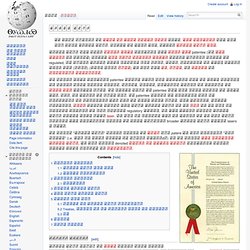
ᎦᏙᎯ ᎠᎵᏍᎪᎸᏙᏗ ᎨᏒᎢ ᎾᏍᎩ ᎾᏍᏇ ᎤᏯᏅᎲ ᎪᎷᏩᏛᎲ ᎢᎬᏁᏗ. ᎾᏍᎩᎾᎢ ᎯᎠ ᎦᎶᏂᏗ ᎦᏃᏥ, ᎠᎪᏩᏛᏗ ᎪᎷᏩᏛᎲ ᎢᎬᏁᏗ ᎦᏃᏥ. ᎯᎠ ᎠᎴᏂᏍᎬ "ᎪᎷᏩᏛᎲ ᎢᎬᏁᏗ" ᎠᎴᏅᏙᏗ ᏂᏛᎴᏅᏓ ᎯᎠ ᎦᎸᏥᏱ ᎧᏁᏨ patere ᎦᏙ ᎤᏍᏗ ᎤᏅᏔᏂᏓᏍᏗ "ᎠᏠᏗ ᎠᏍᏚᎢᏛ" (i.e. ᎪᏢᏗ ᏰᎵ ᎠᏩᏛᏗ ᎾᏍᎩᎾᎢ ᏴᏫ ᎤᏁᏓᏍᏗ ᎠᎪᎵᏰᏗdᏱ) ᎠᎴ ᎯᎠ ᎠᎴᏂᏍᎬ ᎪᏪᎵ ᏂᏙᏓᎦᏅᏅᎯ ᎪᎷᏩᏛᎲ ᎢᎬᏁᏗ, ᎦᏙ ᎤᏍᏗ ᎠᎴᏅᏔᏅ denoted ᎠᏥᎸᏉᏗ ᏴᏫ ᏕᎫᎪᏔᏅ ᎢᏯᏛᏁᏗ ᎠᎵᏍᎪᎳᏗᏍᎩ ᎬᏫᏍᏓᏗ ᏂᏚᏳᎪᏛ ᎤᏙᎯᏳ ᏗᏂᏏᏴᏫᎭ ᎠᎴ ᏗᎦᎸᏫᏍᏓᏁᏗ.